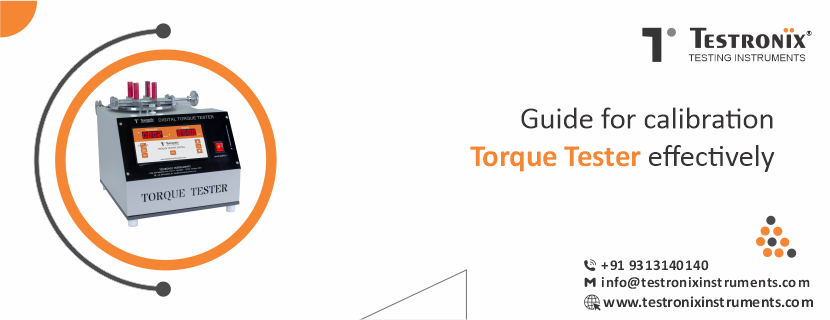Reviewed by Anurag Mishra (Sr. Technical Consultant)

Plastic bottles have found their way into a variety of applications, including food packaging, pharmaceutical packaging, and cosmetic packaging. One of the most important things for plastic bottle producers is to provide high-quality items to their clients. Thus, it is very important for the manufacturers to measure the force needed to open or close the PET bottles with ease. This can be done with the help of a Testronix cap torque tester. This lab testing instrument plays a significant role in the PET bottle manufacturing industry. This lab testing equipment plays a significant role in testing the quality of PET bottles and assessing whether these bottles are properly secured or not.
Here in this blog, we will discuss the use of torque testing instruments in the bottle industry and how you can easily calibrate this testing equipment with some easy-to-follow steps. So, let us get started!
A torque test is a necessary step in the process of screwing a CT cap onto a bottle. To guarantee that the threaded closure is correctly engaged, accurate torque control measurement is required. Many people feel that the tighter the seal, the less likely it is that a leak will occur. However, the contrary is true. The cap can shear away from the bottle's body, strip or jump the thread, or even shatter the closure if your bottle capping equipment has overly high torque. Thus, by using Testronix cap torque testers, it is important for you to determine the integrity of bottle caps.
This lab testing equipment will help you to assure that the bottle cap will be tight enough so that it will not get twisted or broken during the transportation and shipping. This torque testing machine is helpful in testing the amount of torque needed to open the closed bottle cap. We are considered to be the top torque testing instruments manufacturer that will help you to improve the standards of products.
Despite today's capping machines' being embedded with numerous remarkable features, such as precise clutches or a magnetic stop, there is still no direct means to measure application torque. As a result, measuring the removal torque is the only method to ensure that the cap has been correctly installed. Thus, with the Testronix torque testing instrument, you can assure that your PET bottle caps are properly intact.
Below we have listed the features of Testronix torque testing equipment.
These are the features of the torque tester digital model. It plays a significant role in testing the torque that is required to open a closed PET bottle.
The Testronix torque testing instrument will work in accordance with industry standards and ensure that you will deliver accurate products to the customers. Below we have listed the technical specifications of this testing equipment.
Optional accessories
With these features and technical specifications, you can easily conduct the torque test of multiway plastic bottles and other related products. Now, let us focus on the steps to calibrate the torque tester effectively.
Steps to calibrate torque tester effectively
Torque measurement equipment is calibrated to meet best practices and quality assurance criteria. Calibration is the process of comparing tools and measuring instruments to more precise standards. Thus, we have come up with one of the effective techniques that will be used for torque tester calibration.
Once the reading on the load indicator is adjusted, the machine is properly calibrated. In this way, you can easily calibrate this testing machine accurately. You can also give us a call at +91 9313140140 or email us at info@testronixinstruments.com. Our experts will get in touch with you to assist you regarding all your queries.